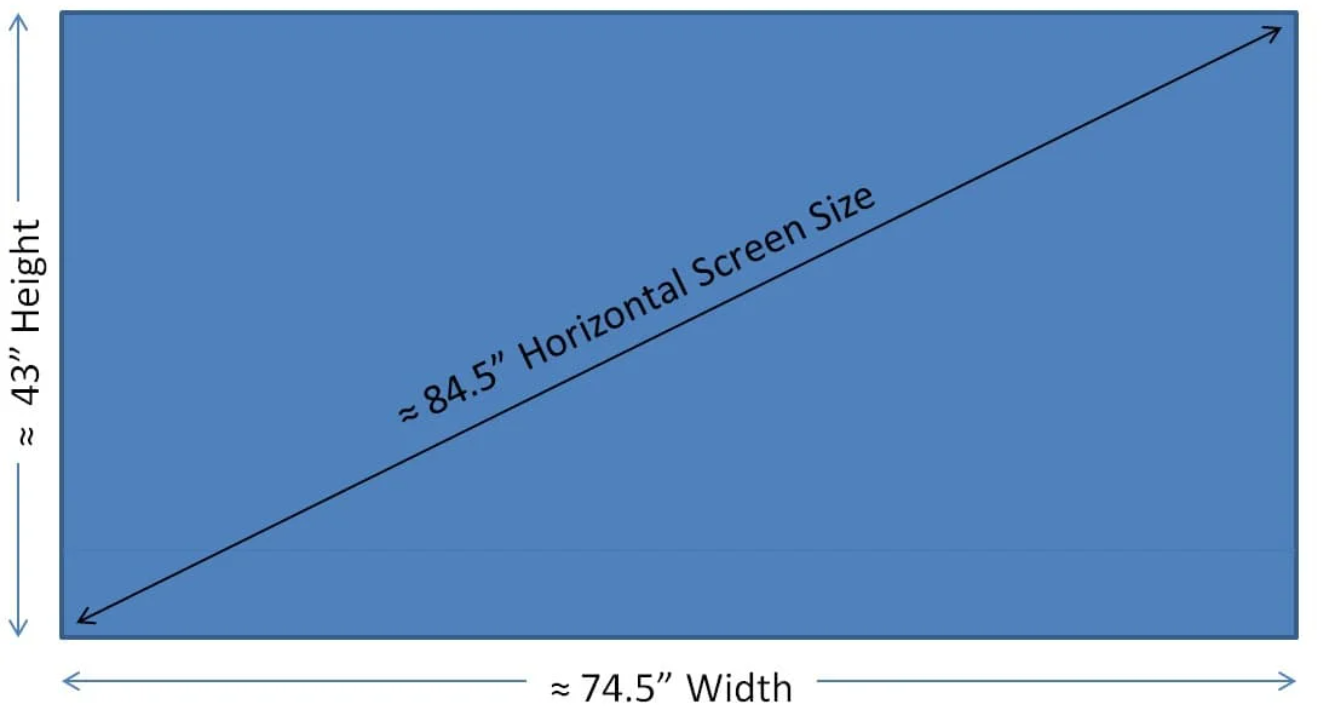How Wide Is an 85 Inch TV? Breaking Down the Dimensions
The demand for larger, more immersive home television viewing experiences has led to the rising popularity of 85 inch TV models. But before purchasing one of these giant screens, it’s important to understand how wide an 85 inch TV is and ensure you have adequate space. This guide breaks down the typical width, width-impacting factors, width considerations for furniture and wall mounts, and why this measurement matters.
Typical Dimensions of 85-Inch TVs
The average 85-inch TV measures right around 75 inches wide. However, exact width specifications can vary slightly between models and brands. Here are some key details on sizing:
- The 85-inch description refers to the diagonal screen size from corner to corner.
- The actual TV width depends on the screen’s aspect ratio and frame dimensions.
- Most modern 85-inch TVs have an aspect ratio of 16:9 or 21:9 widescreen.
- Additional width comes from material borders and bezels surrounding the screen.
- Overall width ranges from 72 inches on the low end to 78 inches on the high end for most 85-inch TVs.
When determining if an 85-inch TV will fit your space, be sure to account for the full width and not just the screen size. The width must accommodate furniture consoles, wall mounts, and room layouts.
Factors That Impact 85-Inch TV Width
While 75 inches serves as a sensible average, what other factors cause the width measurement to vary between 85-inch TV models?
Screen Aspect Ratio
The screen shape and ratio between the vertical and horizontal dimensions impacts a TV’s width needs.
- 16:9 – The most common widescreen aspect ratio for 85-inch TVs falls between 72-76 inches wide.
- 21:9 – Ultra-wide aspect ratios approach and sometimes exceed 78 inches.
So if choosing an extra-wide or curved screen design, account for the boost in width.
Frame, Bezel, and Border Width
Beyond the display area, the external frame, bezel, and borders add extra width:
- Bezel – The outer rim lining the screen averages 0.5 inches.
- Border – The external area with inputs/outputs totals ~1 inch.
Frame – Structural recordings linking rear casing may intrude up to 2 inches on overall width.
So while the screen comprises 85-diagonal inches, external hardware can tack on a few more inches from edge to edge.
Mounting Method: Wall vs TV Stand
Does the 85-inch TV sit on a low-profile stand or mount flush to the wall?
- Wall mounts strictly need to span the TV’s rear width.
- Entertainment stands should exceed the TV’s full front-to-back width.
- This allows for stable placement and overhang space.
Consider the mounting method when measuring to accommodate width. Wall-mounted televisions can get away with slightly smaller furniture widths, since no stand resides beneath the screen.
Measuring Width for Console Tables
For 85-inch TVs placed on console tables or entertainment centers, adequately measuring furniture width presents a core concern. Here are best practices:
- Select console tables around 3-4 inches wider than your TV model’s total width.
- This leaves reasonable overhang space on either side for edges and ventilation.
- The console must resist tipping from the TV’s weight at maximum extension.
- For nearly all 85-inch TVs, console tables between 76 and 80 inches wide provide a stable fit.
Checking that console furniture widths safely support and exceed that of new widescreen TVs allows for a seamless entertainment center arrangement.
Width Needs for Wall Mounting
When wall mounting flatscreen TVs, ensuring widths align between mount equipment and display sizes remains vital for a polished look. For 85-inch TVs, ideal wall mount widths span between 70-82 inches and offer patterns accommodating the rear-mounting holes.
VESA Mounting Standards
The Video Electronics Standards Association (VESA) defines consistent screw patterns for wall mounts and TV brands. 85-inch models usually adhere to one of these three rear-pattern widths:
- 400 x 400 mm
- 600 x 400 mm
- 800 x 500 mm
So when selecting a mount, match widths and VESA patterns perfectly to your 85-inch television model.
Clearance Considerations
Beyond spanning the TV width, wall mounts must provide:
- Access to rear ports/inputs
- Cable management space
- Room for tilting/swiveling
- Heat ventilation airflow
Don’t position mounts flush against walls. Allow a few extra inches of clearance for functionality.
Why Width Matters for Viewing
While measuring width seems trivial during initial setups, this dimension directly impacts long-term viewing experiences in two key ways:
1. Immersive Cinematic Screen – Wider television screens lend a more enveloping, big-screen theater feel in home arrangements. The 85-inch class drags viewers deeper into on-screen stories through sharply expanded scope.
2. Ideal Viewing Width – The ideal viewing width depends on room size and seating distance. Display height should fall at or below a 30-degree viewing angle for comfortable ergonomic viewing. Wider screens thus require pushing seating further back in smaller rooms.
Finally, intelligently positioning width considerations to avoid lighting glare and eye fatigue further elevates enjoyment. So while numerically larger TVs tempt enthusiasts, ensure your 85-inch model aligns sensibly to space for optimizing widths in the viewing environment.
Also Read Other TV Size and Dimensions:
Conclusion
If wondering “how wide is an 85-inch TV?”, the quick answer reflects approximately 75 inches. However, external bezels and variant aspect ratios result in a wider range from 72-78 inches. Carefully measure both the screen and full external width when arranging furniture, wall mounts, and room layouts. Additionally, understand how increased width impacts ideal viewing positions and angles. While 85-inch televisions guarantee jaw-dropping visuals, fine-tuning placement and proportion considerations helps fully realize the grand cinematic experiences these screens enable.
